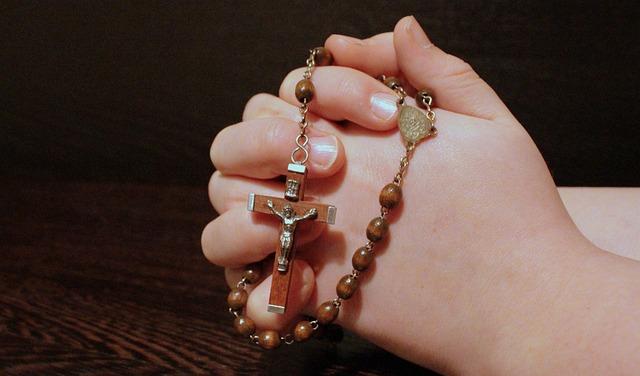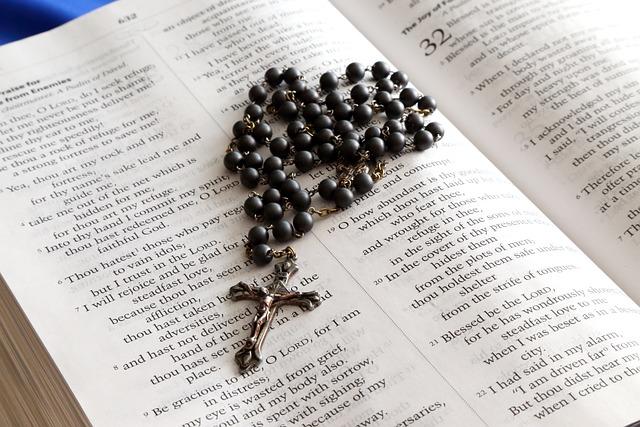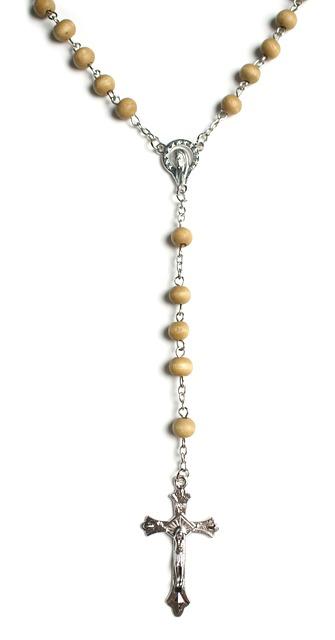How to Draw a Rosary: Creative Expression of Devotion
Drawing a rosary can be a beautiful and creative way to express devotion and faith. Whether you are an artist looking for a new subject to explore or simply wanting to deepen your spiritual connection, learning how to draw a rosary can be a rewarding experience. In this article, we will guide you through the steps to create your own unique and meaningful representation of this sacred symbol. So grab your pencils and paper, and let’s get started!
Contents
- Introduction: Understanding the Symbolism of the Rosary
- Choosing the Right Materials for Drawing a Rosary
- Step-by-Step Guide: Sketching the Beads and Cross
- Adding Intricate Details: Drawing the Rosary Centerpiece
- Incorporating Personal Touches: Customizing Your Rosary Drawing
- Shading Techniques: Bringing Depth to Your Artwork
- Color Options: Selecting a Palette for Your Rosary Drawing
- Tips for Achieving Symmetry and Balance in Your Drawing
- Enhancing Realism: Techniques for Creating a Three-Dimensional Effect
- Final Touches: Adding Highlights and Shadows to Your Rosary Drawing
- Displaying and Sharing Your Art: Creative Ways to Showcase Your Rosary Drawing
- Future Outlook
Introduction: Understanding the Symbolism of the Rosary
The symbolism of the rosary is deeply rooted in the traditions of the Catholic faith, serving as a powerful tool for prayer and meditation. Each bead on the rosary represents a prayer or intention, guiding the faithful through a series of reflections on the life of Jesus and the Virgin Mary. Understanding the significance of these symbols can enhance one’s spiritual connection and deepen their devotion.
Key Symbolism of the Rosary:
- The Cross: Represents the sacrifice of Jesus Christ for the salvation of humanity.
- The Beads: Serve as markers for prayers and meditations.
- The Mysteries: Reflect on important events in the lives of Jesus and Mary.
Exploring the symbolism of the rosary through artistic expression can be a meaningful way to engage with one’s faith. Drawing a rosary allows for a creative and personal interpretation of these sacred symbols, fostering a deeper understanding and connection to the spiritual significance they carry. Whether through sketching, painting, or digital art, the act of visually representing the rosary can be a powerful form of prayer and reflection.
Choosing the Right Materials for Drawing a Rosary
When choosing materials to draw a rosary, it’s important to consider the symbolism and significance of each element. Here are some key components to consider:
Beads:
- Beads are a central part of any rosary drawing. They represent the prayers and intentions of the person using the rosary. Consider using different colors or sizes to add visual interest and depth to your drawing.
Crucifix:
- The crucifix is a powerful symbol of Christ’s sacrifice and redemption. When drawing a rosary, make sure to include a detailed and accurate depiction of the crucifix to emphasize the central importance of Christ in the prayer.
Medals:
- Medals are often included in rosaries to represent specific saints or devotions. Incorporating these medals into your drawing can add a personal touch and connection to the spiritual significance of the rosary.
Chain:
- The chain that connects the beads in a rosary represents the unity and continuity of prayers. When drawing a rosary, pay attention to the intricacies of the chain to create a realistic and cohesive design.
Incorporating these elements thoughtfully and intentionally can elevate your rosary drawing from a simple illustration to a meaningful expression of devotion.
Step-by-Step Guide: Sketching the Beads and Cross
To start sketching the beads and cross of a rosary, you will need to gather the necessary materials such as a pencil, eraser, paper, and ruler. Once you have everything you need, follow these simple steps to create a beautiful representation of this sacred object:
- Begin by drawing a small circle for the first bead at the top of your paper. Make sure to leave enough space in between each bead for the cross to fit later on.
- Next, draw a straight line down from the bottom of the first bead to represent the string holding the beads together. Repeat this process for each bead, spacing them evenly along the line.
- Once you have sketched all the beads, draw a larger circle at the bottom of the line to represent the cross. You can add additional details like a crucifix or decorative patterns to make it more visually appealing.
- Lastly, use your ruler to connect the top of the first bead to the top of the cross with a straight line. This will complete the sketch of the rosary, showcasing the connection between the beads and the cross in a harmonious way.
Adding Intricate Details: Drawing the Rosary Centerpiece
When it comes to drawing the intricate details of a rosary centerpiece, attention to detail is key. The rosary centerpiece is a focal point of the entire rosary, symbolizing important aspects of faith and devotion. Here are some tips on how to beautifully draw the rosary centerpiece:
- Start with a rough sketch: Before diving into the intricate details, start by sketching out the basic shape and design of the rosary centerpiece. This will help you plan out the layout and composition of the piece.
- Focus on symmetry: The rosary centerpiece often features symmetrical designs, such as crosses, religious symbols, and intricate patterns. Pay close attention to symmetry as you draw each element to create a harmonious overall look.
- Use fine detailing: To make the rosary centerpiece truly stand out, add fine detailing such as delicate lines, shading, and intricate patterns. This will elevate the overall design and make it more visually appealing.
- Consider adding color: While traditional rosaries are often depicted in black and white, adding color to the centerpiece can add depth and dimension to your drawing. Experiment with different color combinations to create a unique and eye-catching final piece.
Incorporating Personal Touches: Customizing Your Rosary Drawing
One way to make your rosary drawing unique is to incorporate personal touches that have special significance to you. You can customize your rosary drawing by adding elements that reflect your own interests, beliefs, or experiences. This allows you to create a one-of-a-kind piece of art that is meaningful to you on a personal level.
Here are some ideas for incorporating personal touches into your rosary drawing:
– Use colors that have a special meaning to you, such as your favorite color or a color that represents something important in your life.
– Include symbols that are significant to you, such as a favorite flower, animal, or religious symbol.
– Add details that reflect your cultural background or heritage, such as patterns or designs that are traditional in your culture.
– Personalize the rosary beads by adding initials, dates, or words that hold personal significance to you.
By customizing your rosary drawing in these ways, you can create a truly unique and personal piece of art that reflects your own journey of faith and devotion. Let your creativity and individuality shine through in your drawing to make it a meaningful and special representation of your spiritual practice.
Shading Techniques: Bringing Depth to Your Artwork
When it comes to drawing a rosary, there are various shading techniques that can bring depth and dimension to your artwork. By mastering these techniques, you can create a beautiful and expressive representation of devotion.
One technique to consider is cross-hatching, which involves drawing parallel lines in a crisscross pattern to create shadows and highlights. This method is great for adding texture and depth to the beads of the rosary.
Another shading technique to use is stippling, which involves creating tiny dots to build up tones and create a sense of volume. This method can be used to add dimension to the intricate details of the cross and medallions on the rosary.
Additionally, blending is a useful shading technique that involves smoothing out transitions between light and dark areas. You can use a blending tool or your finger to create a seamless gradient of tones, enhancing the three-dimensional effect of your rosary drawing.
Color Options: Selecting a Palette for Your Rosary Drawing
When selecting a color palette for your rosary drawing, it’s important to consider the symbolic meanings associated with different colors. Each color can evoke different emotions and feelings, so choosing the right combination can enhance the overall message of your artwork.
Here are some popular color options to consider when drawing your rosary:
– **White**: Represents purity, innocence, and peace. It is often associated with the Virgin Mary and can be a powerful symbol of devotion.
– **Blue**: Symbolizes the heavens, truth, and faith. It is a calming color that can bring a sense of serenity to your drawing.
– **Gold**: Signifies wealth, royalty, and divinity. It can add a touch of luxury and elegance to your artwork.
– **Green**: Represents growth, renewal, and hope. It can symbolize new beginnings and the eternal cycle of life.
By carefully selecting a color palette that resonates with you, you can create a visually stunning and emotionally impactful rosary drawing that reflects your devotion and creativity. Experiment with different combinations to find the perfect balance of colors that speaks to your heart.
Tips for Achieving Symmetry and Balance in Your Drawing
Drawing a rosary can be a beautiful and meaningful way to express devotion through art. To achieve symmetry and balance in your drawing, consider the following tips:
– Start by sketching the central cross of the rosary in the middle of your paper. This will serve as the focal point of your drawing and help you establish symmetry.
– Use a ruler or a straight edge to draw the straight lines of the rosary beads. Make sure to space them evenly to create a sense of balance throughout the drawing.
– Incorporate intricate details such as the beads and the connecting chains to add depth and realism to your artwork. Focus on creating clean lines and smooth curves to enhance the overall symmetry of the rosary.
– Experiment with different shading techniques to bring depth and dimension to your drawing. By adding light and shadow, you can further enhance the balance and symmetry of your artwork.
Remember, drawing a rosary is a creative and personal expression of devotion. Take your time, pay attention to detail, and enjoy the process of creating a work of art that reflects your faith and spirituality.
Enhancing Realism: Techniques for Creating a Three-Dimensional Effect
Creating a realistic three-dimensional effect in your drawings can greatly enhance the overall impact of your artwork. One effective technique for achieving this level of realism is by focusing on creating depth and dimension in your drawings. By utilizing shading and perspective, you can bring your drawings to life and make them appear more lifelike.
To create a three-dimensional effect when drawing a rosary, start by carefully observing the object and noting the various shapes and angles that make up its structure. Pay attention to the ways in which light hits the rosary beads and how shadows are cast on them. By accurately representing these details in your drawing, you can create a more realistic and convincing depiction of the rosary.
Experiment with different shading techniques to add depth and dimension to your drawing. Use a combination of hatching, cross-hatching, and blending to create a smooth transition between light and shadow. By carefully considering the light source and the direction in which it falls on the rosary beads, you can create a more realistic representation of the object.
Consider adding elements of perspective to your drawing to further enhance the three-dimensional effect. By varying the size and spacing of the rosary beads as they recede into the background, you can create the illusion of depth and distance. Remember to adjust the level of detail and definition in each bead to create a sense of space and realism in your drawing.
Final Touches: Adding Highlights and Shadows to Your Rosary Drawing
To add the final touches to your rosary drawing, you will want to focus on adding highlights and shadows to create depth and dimension. This will help make your drawing more realistic and visually appealing. Here are some tips on how to effectively incorporate highlights and shadows into your rosary drawing:
Highlights:
– Use a white colored pencil or marker to carefully add highlights to the beads of the rosary. Focus on areas where light would naturally hit the beads, such as the tops and sides.
– Blend the highlights into the surrounding colors using a blending stump or your finger to create a smooth transition.
– Pay attention to the light source in your drawing to ensure that the highlights are placed consistently throughout.
Shadows:
– Use a darker shade of the color of the beads to create shadows. Concentrate on areas where light would be blocked or where objects overlap.
– Use cross-hatching or stippling techniques to add depth to the shadows and create a more realistic effect.
– Experiment with different levels of darkness to achieve the desired shadow intensity.
By adding highlights and shadows to your rosary drawing, you can elevate your artwork and bring it to life. Take your time, practice, and don’t be afraid to experiment with different techniques to create a unique and visually stunning piece of art.
Displaying and Sharing Your Art: Creative Ways to Showcase Your Rosary Drawing
One fun way to display your rosary drawing is by framing it and hanging it on a wall in your home. This not only showcases your artwork but also serves as a constant reminder of your devotion. Choose a stylish frame that complements your drawing and select a prominent spot where it can be easily admired.
Another creative way to share your rosary drawing is by creating personalized greeting cards featuring your artwork. You can digitally scan your drawing and print it on high-quality cardstock to make unique and meaningful cards for special occasions. Add a heartfelt message inside each card to truly personalize your creation.
If you enjoy crafting, consider incorporating your rosary drawing into a DIY project. For example, you could transfer the image onto a canvas tote bag or a ceramic mug using transfer paper. This personalized touch adds a special element to everyday items and allows you to share your artwork in a practical way.
For those who are tech-savvy, you can also digitize your rosary drawing and share it on social media platforms or your personal blog. Use hashtags related to art or spirituality to reach a wider audience and connect with like-minded individuals who appreciate your creative expression of devotion. Embrace the digital age and showcase your artwork to the world through online platforms.
Future Outlook
In conclusion, drawing a rosary is a beautiful way to creatively express your devotion and faith. By following the steps outlined in this article, you can create a meaningful piece of art that reflects your spiritual beliefs. So, pick up your pencil and paper, and let the creativity flow as you embark on this artistic journey of faith. Remember, there are no limits to where your imagination can take you. Happy drawing!



















 ANCIENT PINEAL ACTIVATION FORMULA
ANCIENT PINEAL ACTIVATION FORMULA